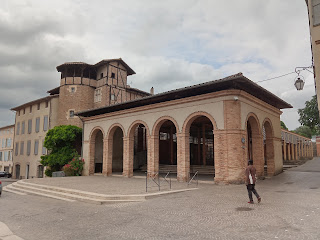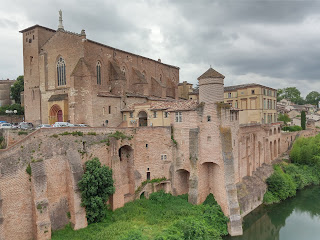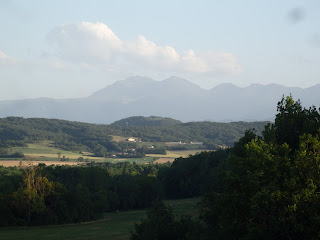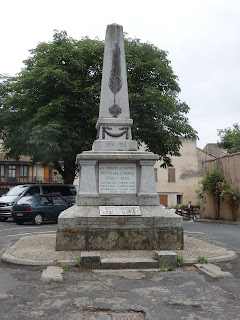June 18, 2024
No map today as it was a quiet day at Le Cazal. Katie, Randy, and the girls left for their Spanish adventures around 11 - sad for us, exciting for them. The foggy, hazy day slowly became warmer, bluer and sunnier so that by lunch we could eat outside. A warm breeze kept the patio from becoming too hot.
After a bit of tidying up, I stitched outside with an eye on our mountains. Dave did a 2-hour hike that started and ended in Mirepoix. The countryside around us is so beautiful and peaceful.
 |
| What happens after 100 years or more when houses are abandoned. |
We were going to have leftovers for dinner, but were satisfied with our aperos. I sat outside until 8 when the breezes turned cool and Dave lasted until 9, finishing a bottle of Tavel that we had opened for aperos.
June 19. 2024
Today we are driving north to visit as many as possible of 4 villages - Lautrec, Gaillac, Lisle-sur-Tarn, and Rabastans. It's not clear we can do all of them in one day, but we'll see where time and interest lead us. With lunches packed, we headed north about 9:30 this morning.
Lautrec advertises itself as a Pays de Cocagne (a land of plenty, from a medieval myth/fable that described an imaginary land where everyone had all they needed, there were constant parties and entertainments, and no one had to work). Cocagne is also the name for the ball of dye crystals made from processing woad (a flowering plant), a long, labor-intensive process. But one that made this area very wealthy.
 |
| Cocagnes of pastel (https://tourism.auxsourcesducanaldumidi.com/pastel-or-woad ) |
Driving toward Lautrec certainly looked like a land of plenty. Broad valleys stretched for miles, covered in crops - wheat, corn, sunflowers, colza (rape seed - for making canola oil) and crops we couldn't recognize.
 |
| fields around Lautrec |
Lautrec is an hour north east of the city of Toulouse. Ancestors of Aristocrat and Post-Impressionist painter, Henri de Toulouse-Lautrec were rulers of these cities, but Toulouse-Lautrec never lived in Lautrec. He just made the name of the town famous.
This formerly walled bastide village perches on a rocky outcropping making for lots of hilly streets within the village. Our first task was to find the tourist office, which involved pushing me up a rather long steep hill to the top of Rue du Mercadial. Heading back down this main street into the center of town, the tourist office is immediately on the left inside the former Benedictine convent.
 |
| map of Lautrec's centre-ville |
A bit tricky to notice (there is only a small sign on the street), the tourist office has a lovely setting, opening off the cloister garden of the convent and overlooking the landscape outside the village.
The former convent bakery can be seen just inside the cloister from Rue du Mercadial.
The mayor's office is also located in the convent, but its entrance is on the Rue du Mercadial.
We continued down Rue du Mercadial, past the former Holy Savior chapel which once belonged to the Knights Templar and was given to the city in 1692.
Further down the street is a set of shops selling clothing and other articles dyed in blue, a reminder of the economic riches made in this area during medieval times from growing and processing "le pastel" (Isatis tinctoria) (woad in English), which produces a plant-based blue dye. (more information here, although you'll need to translate it into English: https://www.tela-botanica.org/2016/04/article7441/ or here: https://tourism.auxsourcesducanaldumidi.com/pastel-or-woad (in English)
 |
| Rue du Mercadial |
Only one of the 8 town gates remains from it's medieval fortifications and it is a good indicator of the hilly nature of this town.
 |
| Porte de la Caussade |
 |
| looking back uphill from Porte de la Caussade |
The town, a Plus Beau Village, is a bastide town with the usual arcaded houses surrounding a central square encircled by defensive walls.
 |
| remains of defensive walls |
However, this bastide has a pentagonal central square and only half of the houses around the square are arcaded. The central square is missing a covered market, but showcases a fountain.
Also a bit unusual, the arcades shelter only a few shops, but also doors (even garage doors) to living quarters. One such door was open so I was able to peek in as the house was being emptied for the new owners (notice the sold sign on the door).
It was here that I first noticed the bundles of wheat alternating with flowers decorating the arcades. These are lucky charms, according to this blog: https://www.villademazamet.com/local-area/lautrec-a-quintessential-french-village/ but must be made with 7 twigs on the 7th hour of the 7th day of the 7th month. Whew, that's a lot of 7s.
 |
| a bundle of wheat on the right |
Continuing further, we found the war memorial for WWI and WWII. Every French town has one. A whole generation of French men was lost in the hand-to-hand combat of WWI as evidenced by the 90+ names inscribed on the memorial (for a town of less than 2000 people). The contrast with WWII is huge as warfare was more mechanized and France capitulated to the Germans and lived under the Vichy puppet government. In that war, only 7 soldiers lost their lives. These very public monuments make it easy to pause to remember the terrible costs of war.
 |
| The first of 3 panels listing the names of sons lost in WWI |
Finally, at the end of the street, we visited the collegiate church of St Rémy de Lautrec. (A collegiate church is like a cathedral, but not headed by a bishop.) Well set up in both accessibility and English information, the most stunning feature(s) of this church are its trompe-l'oeil decoration. What looks like carved stone features is really just painting. Well, not just painting, but REALLY GOOD painting.
 |
| these are paintings, not sculptures |
 |
| once again, the chapel arches are painted, not carved |
 |
| the ceiling |
Collégiale St Rémy de Lautrec is a beautifully decorated and maintained church in Southern Gothic style.
The oldest part of this village is down hill where half-timbered houses and narrow alleys lead out of town.
Unfortunately, the last site we wanted to visit is UPHILL and so Dave patiently helped push me up the narrow streets to the top of the rocky spur where a working windmill still grinds wheat. (However, it's not open today.) But the view is worth the effort, even if it is cloudy today.
Still farther above is the the Calvaire de la Salette, (Christ on the cross) with a viewpoint over the surrounding countryside.
 |
| the Occitan cross in flowers |
 |
| the church and town overlook productive farmland |
 |
| the weather was beginning to threaten rain, although it was still quite warm |
We walked down the side of the hill where the windmill is located and found a bench outside the old city walls. Dave moved the car and we ate lunch looking up at the old town.
 |
| We were watched over as we ate |
 |
| the statue of Mary is at the top of the wall in front of the light tan building |
 |
| Behind Dave was the parking lot. There were several campers parked here. |
By now, it was already after 2, so we headed to Gaillac. This town of 15,000 is known for its wines. We found parking just around the corner from La Place de la Liberation and found the tourist office across the street (much easier than Lautrec!). Armed with a town map, we started from the Place de la Liberation. Many towns remember when they were liberated from German occupation in WWII, either with a square or street name.
 |
| map of Gaillac's "centre-ville" |
 |
| war memorial on Place de la Liberation |
 |
| Place de la Liberation invites people to hang out |
Gaillac has a different vibe from the old town of Lautrec. Not surprising, given its size and its commerce in wine. People were out and about, in cafes or sitting with friends on park benches. Banks and shops around the square were busy.
Gaillac's wines have been known for a thousand years. Vines were first planted in the 1st century BC when the town was Roman. But it became known for its wines when the Benedictine monks of the St Michel de Gaillac Abbey improved the stock and and the wine's reputation in the 10th century.
 |
| St Michel de Gaillac Abbey church |
We traveled down the picturesque Rue Portal, stopping at the St Peter's church (Église St Pierre), a fortified southern gothic church.
 |
| Eglise St Pierre |
 |
| Interior of Eglise St Pierre |
Much of Gaillac's architecture is from the 15th-17th centuries, using the red brick so popular in this region.
The Place du Grifoul is the market square of the city, although its covered market has been renovated into a modern indoor market. A 16th century fountain remains in the center of the square.
 |
| covered market is now larger and indoors |
 |
| fountain on Place Grifoul |
 |
| center of Place du Grifoul |
We worked our way through the old city to the Tarn River with its impressive Abbey de St Michel de Gaillac towering over the banks. The view from across the Tarn River is worth the walk across the bridge.
 |
| Abbey of St Michel de Gaillac |
The Tarn played an important part in the growth of Gaillac, serving to transport both wine and woad internationally. Where there once was a set of locks on the river, there is now a hydroelectric plant.
 |
| Gaillac seen from the Tarn River |
 |
| hydroelectric plant was built over the former locks |
 |
| in the tasting room |
 |
| courtyard of the maison de vin |
June 20, 2024
We had thunderstorms last night and rain pretty much all night. Today has been a total washout with rain and fog the entire day. So the day was spent catching up on the blog, doing a few chores, and eating in Mirepoix for dinner. Although we were too early to order dinner, in usual American fashion (it was 5:30). But we had skipped lunch and I was hungry. So we had a charcuterie platter for 2 and ice cream for dessert at the St Maurice. Needless to say, it was quiet downtown. We were able to park in the church parking lot and stay under the cover of the arcaded buildings all the way to the restaurant.
 |
| a pichet 50 cl of rosé |
 |
| our charcuterie board - they must have known we are American - notice the glass of ice cubes for our water. |
 |
| Le Saint Maurice |
Not a bust of a day, just a quiet day. Tomorrow's weather promises to be better.






























No comments:
Post a Comment